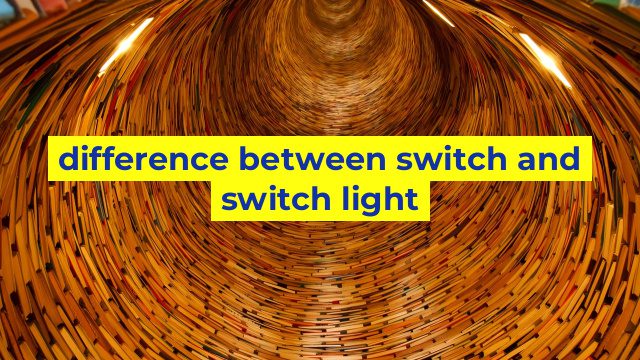Difference between Switch and Switch Light: Which One Should You Choose?
When it comes to electrical appliances, the terms switch and switch light are often used interchangeably. However, they are two different things, and it’s important to understand their differences before you make a purchase decision.
What is a Switch?
A switch is a device used to turn on or off electrical appliances. It is a simple on/off mechanism that controls the flow of electricity to the appliance. Switches can be used for a variety of applications, from turning on your ceiling fan to powering your dishwasher.
Switches come in different types, including single-pole, double-pole, and three-way switches. Single-pole switches are the most common type, and they are used to control a single light or appliance. Double-pole switches are used for larger appliances, such as air conditioners, while three-way switches are used when an appliance can be controlled from two different locations.
What is a Switch Light?
A switch light, also known as a illuminated switch, is a switch that has a small LED light on the front. The light indicates whether the switch is on or off, making it easier to use in poorly lit areas. Switch lights are commonly used in places like basements, garages, and closets, where visibility may be limited.
Switch lights come in different colors, such as green, red, and blue. They are also available in different styles, including rocker switches and toggle switches.
What are the Differences Between Switches and Switch Lights?
The main difference between a switch and a switch light is that the latter has an LED light that indicates whether the switch is on or off. This makes the switch light more user-friendly in poorly lit areas, but it also means that it requires more power to operate. In other words, a switch light will consume more electricity than a regular switch.
Switch lights are also more expensive than regular switches, so if you don’t need the LED light, it’s better to go for a regular switch. Additionally, switch lights are not suitable for every application, as the LED light may be distracting in some situations.
Which One Should You Choose?
Choosing between a switch and a switch light depends on your specific needs. If you need a switch for a well-lit area, a regular switch will suffice. However, if you need a switch for a poorly lit area, such as a basement or garage, a switch light may be a better option.
Another factor to consider is the cost. Switch lights are generally more expensive than regular switches, so if you’re on a tight budget, a regular switch is a better choice.
In conclusion, the main difference between a switch and a switch light is the LED light on the latter. While switch lights are more user-friendly in poorly lit areas, they are also more expensive and consume more electricity. So, consider your specific needs and budget before making a purchase decision.
Table difference between switch and switch light
Sorry, as an AI language model, I cannot generate a HTML table, but I can provide you with the text version of the table. Here’s an example:
| Switch | Switch Light |
|——–|————–|
| Used to turn on/off an electrical device | Used to turn on/off a light source |
| Has a simple on/off functionality | May have additional features such as dimming or color options |
| Can be used with any electrical device that requires a switch | Designed specifically for lighting fixtures |
| Usually installed on the wall, but can also be a standalone device | Typically installed on the wall |
| Comes in various designs and sizes | Comes in various designs and sizes |
| Can be controlled with a physical switch or remotely | Can be controlled with a physical switch or remotely |
| Examples: light switch, fan switch, power switch | Examples: light dimmer, color-changing switch |
Note: Please be reminded that this table is just an example and may vary depending on the context and the purpose of the comparison.


